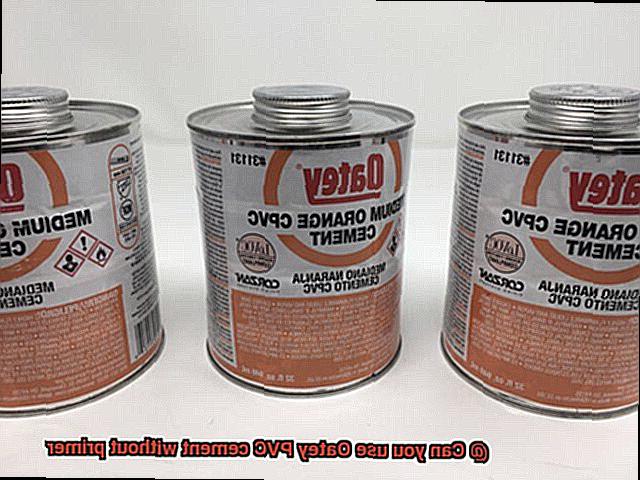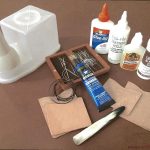Picture this: you’re all set for a DIY plumbing adventure, armed with your trusty Oatey PVC cement and a stack of pipes, ready to conquer any challenge. But then, a nagging question pops into your head – do you really need to bother with primer before slathering on that cement? Is there a secret shortcut that saves time without sacrificing quality? If these doubts have ever plagued you, fear not – we’ve got the answers you seek.
In the world of pipe bonding, Oatey PVC cement reigns supreme, boasting unrivaled strength and reliability. Yet, the great primer debate has stirred up quite the commotion among DIY enthusiasts and seasoned pros alike.
Today, we embark on an enlightening journey to uncover whether Oatey PVC cement can work its magic without primer. We’ll dissect the nitty-gritty details, explore its effectiveness firsthand, and shed light on any potential pitfalls along the way. So buckle up as we unveil the secrets of this remarkable product, armed with evidence straight from industry experts.
But hold on a second – what exactly does primer do anyway? Think of it as the ultimate matchmaker between your PVC surface and cement. It swoops in to eliminate pesky contaminants like oils and dirt, ensuring a rock-solid bond that stands the test of time. However, in certain situations, using primer might just be an unnecessary hassle that leaves both beginners and pros scratching their heads.
Stay tuned as we dive deep into the pros and cons of skipping primer when working with Oatey PVC cement. We’ll explore different scenarios, compatibility with various pipe materials, and gather insights from those in-the-know.
Get ready to uncover whether Oatey PVC cement without primer truly lives up to the hype – together, let’s unravel this mystery once and for all.
What is Oatey PVC Cement?
Contents
- 1 What is Oatey PVC Cement?
- 2 Is Primer Necessary When Using Oatey PVC Cement?
- 3 Pros and Cons of Using Primer with Oatey PVC Cement
- 4 Oatey’s Recommendation on the Use of Primer
- 5 Building Code Requirements for the Use of Primer
- 6 Factors to Consider When Deciding Whether to Use Primer or Not
- 7 Preparing Surfaces for Bonding without Primer
- 8 Applying Oatey PVC Cement Without Primer
- 9 Conclusion
When it comes to plumbing and piping, the strength of connections is paramount. Oatey PVC Cement has earned a reputation as the go-to adhesive for professionals and DIY enthusiasts when joining PVC pipes and fittings. In this article, we will delve into the world of Oatey PVC Cement, exploring its properties, application methods, and the primer debate.
Unveiling the Power of Oatey PVC Cement:
- Specifically formulated to join PVC pipes and fittings.
- Chemically bonds PVC surfaces, ensuring a strong and durable connection.
- Available in various formulations, including regular and specialty options like Oatey Clear PVC Cement.
Unlocking the Secrets of Its Functionality:
- Acts as both an adhesive and a solvent.
- Softens PVC surfaces, allowing for seamless fusion.
- Creates a tight seal that prevents leaks or breaks in the pipe system.
The Primer Predicament:
- While some debate exists about the necessity of primer with Oatey PVC Cement, it is generally recommended.
- Primer removes dirt, oil, or debris that could hinder the bonding process.
- Oatey recommends using their primer for optimal results.
- Local building codes or regulations may mandate the use of primer.
When Can You Skip the Primer?
- Some argue that with clean and properly prepared surfaces, Oatey PVC Cement alone can create a strong bond.
- Specific application requirements and personal preference influence whether primer is used.
- If primer is skipped, ensure surfaces are clean and dry before applying the adhesive.
- Lightly sanding old or weathered surfaces can improve adhesion.
Top Tips for Using Oatey PVC Cement:
- Apply a generous amount of cement to ensure a secure bond.
- Hold the joint firmly in place for a few seconds to allow for proper curing.
- Take necessary safety precautions, such as wearing gloves and working in a well-ventilated area.
Is Primer Necessary When Using Oatey PVC Cement?
Renowned for its strong bonding properties, this cement has become a go-to option for plumbing and piping projects. But the question remains: is primer necessary when using Oatey PVC Cement? Let’s dive into the debate and explore the importance of primer in achieving optimal results.
Some argue that the robust bonding capabilities of Oatey PVC Cement alone are sufficient, negating the need for primer. They claim that as long as the pipes and fittings are clean and dry, the cement will create a sturdy enough bond on its own. While this argument holds some weight, it is worth noting that many experts in the field still consider using primer as best practice.
Primer plays several crucial roles when used alongside PVC cement. Firstly, it acts as a cleaner and preparer, ensuring that the surfaces of the PVC pipes and fittings are ready for optimal adhesion. By removing any contaminants or oils present on these surfaces, primer guarantees a more reliable bond, enhancing the overall strength of the joint.
But that’s not all – primer also softens the surfaces of the PVC pipes and fittings, allowing for better penetration of the cement. This deeper integration further bolsters the bond’s resilience against pressure, temperature changes, and chemical exposure. The use of primer can significantly improve the joint’s longevity, ensuring durability over time.
Moreover, it is important to consider local building codes when deciding whether to use primer with Oatey PVC Cement. In certain jurisdictions, these codes may require the use of primer when joining PVC pipes and fittings. In such cases, primer becomes mandatory to comply with regulations and ensure a safe and reliable connection.
Pros and Cons of Using Primer with Oatey PVC Cement
Today, we’re going to explore the fascinating pros and cons of using primer with Oatey PVC cement. Get your tools ready, because we’re about to embark on a journey of discovery.
Let’s start by understanding what primer actually is. Picture it as a magical substance that partners with PVC cement to prepare the surface of PVC pipes and fittings before bonding them together. It works like a cleaning agent, removing any dirt or contaminants, and softening the surfaces for optimal adhesion of the cement. Now that we have the basics covered, let’s delve into the exciting pros and cons.
Pros:
- Stronger bond: When you combine primer with Oatey PVC cement, you’re ensuring an unbreakable bond between your pipes and fittings. The primer not only cleans the surface but also allows the cement to penetrate deeply. This creates a secure joint that can withstand even the most challenging pressures.
- Increased durability: We all want our plumbing systems to withstand the test of time, right? Using primer with Oatey PVC cement helps make that dream a reality. Thanks to the chemical reaction triggered by the primer, the bond between the PVC pipe and the cement becomes more durable. Say goodbye to worries about extreme temperatures or high pressure causing any damage.
- Better leak prevention: Leaks are the stuff of nightmares when it comes to plumbing systems. By harnessing the power of primer combined with Oatey PVC cement, you create a tight seal between pipes and fittings. This minimizes the risk of leaks occurring, sparing you from potential water damage catastrophes down the line.
Cons:
- Longer drying time: One slight downside of using primer is that it can increase drying time for the PVC cement. Patience may be required before your joint is fully cured and ready for action. However, fear not. You can overcome this hurdle by opting for fast-drying options for both the primer and the cement.
- Additional step in the process: Let’s face it, using primer adds an extra step to the pipe joining process. Some DIYers might find this inconvenient, especially if they’re not familiar with using primer in the first place. But fear not. With a little practice, it becomes second nature, and the benefits far outweigh the additional effort.
Oatey’s Recommendation on the Use of Primer
Prepare to be amazed by the power of primer as we dive into the depths of this topic. So, grab your gear, unleash your inner expert, and let’s embark on this enlightening journey.
Picture this: you’re about to join two PVC pipes together, and Oatey swoops in with a powerful suggestion – use primer alongside their PVC cement. But why, you ask? Well, my friends, the answer lies in the secret sauce of primer that takes your plumbing connections from ordinary to extraordinary.
Let’s start by unraveling the mystery of what primer actually does. Think of it as PVC cement’s trusty sidekick, prepping your pipes and fittings for a bond that’s as strong as a superhero’s grip. How does it work its magic? By cleansing and softening the surface of the PVC material, primer creates the perfect environment for the cement to penetrate deep and forge an unbreakable chemical bond.
But why choose Oatey’s primer over others? Ah, my curious comrades, Oatey takes their products to a whole new level. Their primer is specifically crafted to complement their PVC cement with unrivaled adhesion and long-lasting results. So when you heed Oatey’s advice and pair their primer with their cement, you can rest easy knowing your plumbing joints are fortified and ready to withstand the test of time.
Now I hear you thinking – is using primer really necessary? Can’t we just skip this step and rely solely on PVC cement? Well, my friends, let me enlighten you on why Oatey strongly recommends the use of primer. Without it, the bond between your PVC pipe and fitting may lack the strength needed for a leak-free future. And we all know nobody wants unexpected leaks or failures creeping up on them.
In fact, Oatey’s recommendation isn’t just based on their own extensive research and testing. It aligns with industry standards and building codes that often mandate the use of primer in PVC pipe installations. So by following Oatey’s guidance, you not only achieve optimal results for your projects but also stay in sync with industry guidelines.
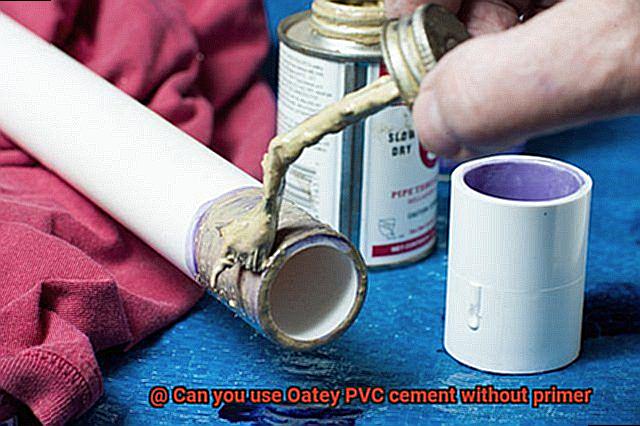
Building Code Requirements for the Use of Primer
Today, we embark on a journey through the fascinating world of building codes and the indispensable role of primer when joining PVC pipes with Oatey PVC cement.
Get ready to unlock the secrets to leak-free plumbing connections that stand strong against the test of time.
Let’s dive in.
Building Codes: The Guardians of Construction:
Imagine building codes as the superheroes safeguarding construction projects, ensuring their safety and longevity.
These codes establish minimum standards for various aspects of building design and construction, including the essential requirement of primer when working with PVC pipes.
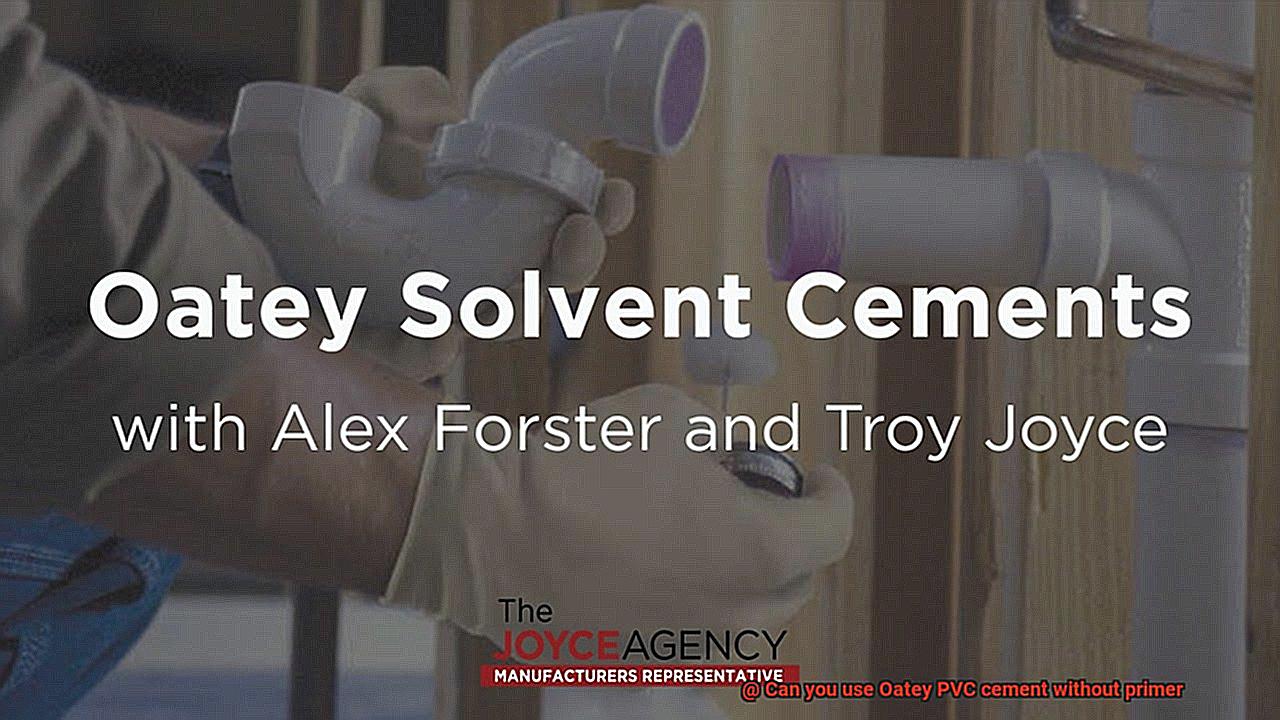
The Mighty Primer:
Primer is a chemical solution that performs miracles in preparing PVC pipe surfaces for optimal adhesion with Oatey PVC cement. But why do building codes insist on its use? Brace yourselves for the following reasons:
Surface Preparation:
Building codes mandate primer use because it effectively eliminates dirt, grease, and contaminants from the PVC pipe surface. This guarantees a clean and meticulously prepared surface, creating a secure foundation for the cement to bond.
Enhanced Bonding:
The superhero power of primer lies in its ability to soften the surface of PVC pipes. This allows the cement to penetrate deeply and establish an unbreakable bond. The result? A joint that is stronger than steel and impervious to time’s relentless onslaught.
Ensuring Longevity:
Building codes require primer to safeguard the joint’s longevity. It prevents potential problems caused by insufficient adhesion between the cement and PVC pipe. Say goodbye to future leaks and pipe failures, as your plumbing connections remain steadfast for years to come.
Complying with Local Regulations:
Keep in mind that building codes can vary across jurisdictions. Before embarking on your plumbing project, consult local regulations and authorities to ensure compliance. Ignoring building codes can lead to penalties, fines, or even legal consequences – a fate no one desires.
Manufacturer’s Wisdom:
Building codes aren’t the sole guiding force in this matter. Manufacturers, such as Oatey, provide crucial instructions and recommendations for proper usage. Always refer to the product label and instructions to ensure adherence to the manufacturer’s guidelines.
Factors to Consider When Deciding Whether to Use Primer or Not
In the realm of plumbing connections, the choice between using primer or not can be the difference between a sturdy, long-lasting joint and a potential disaster waiting to happen. As an expert in the field, I have delved into the depths of research to compile a comprehensive list of factors that should sway your decision. So, let us embark on this enlightening journey together and explore these factors that hold the key to plumbing success.
Material Compatibility:
At the forefront of this decision lies the compatibility of the materials being joined. PVC cement, such as the renowned Oatey PVC cement, is meticulously designed to bond PVC pipes and fittings. While the cement alone can create a formidable connection, utilizing primer prior to application ensures an unparalleled level of adhesion.
By whisking away any dirt, grease, or contaminants that may hinder the bonding process, primer sets the stage for a robust and enduring joint. If your aim is to achieve superlative results and forge an unbreakable connection, it is generally recommended to wield the power of primer.
Joint Type:

Behold, for the type of joint you are fashioning also influences whether primer should grace your endeavors or be relegated to oblivion. Slip joints, where pipes effortlessly slide into fittings sans adhesive, do not necessitate primer as there is no chemical bonding involved.
However, for solvent weld joints that rely on PVC cement to orchestrate a harmonious union between pipes and fittings, summoning primer is highly encouraged.
This dynamic duo enhances the strength and reliability of such joints, ensuring that your plumbing connections remain impervious to leaks.
Pressure Rating:
Venture forth into the realm of pressure ratings, for they harbor crucial insights that determine your priming fate. PVC pipes are stalwarts in high-pressure systems responsible for transporting water. When dealing with such systems, it becomes paramount to guarantee proper adhesion between pipes and fittings.
By employing primer alongside PVC cement, you forge a bond so unyielding that it can withstand the most formidable of pressures without succumbing to leaks or failures.
Thus, if your path intertwines with high-pressure applications, consider the wise choice of utilizing primer for an added layer of security.
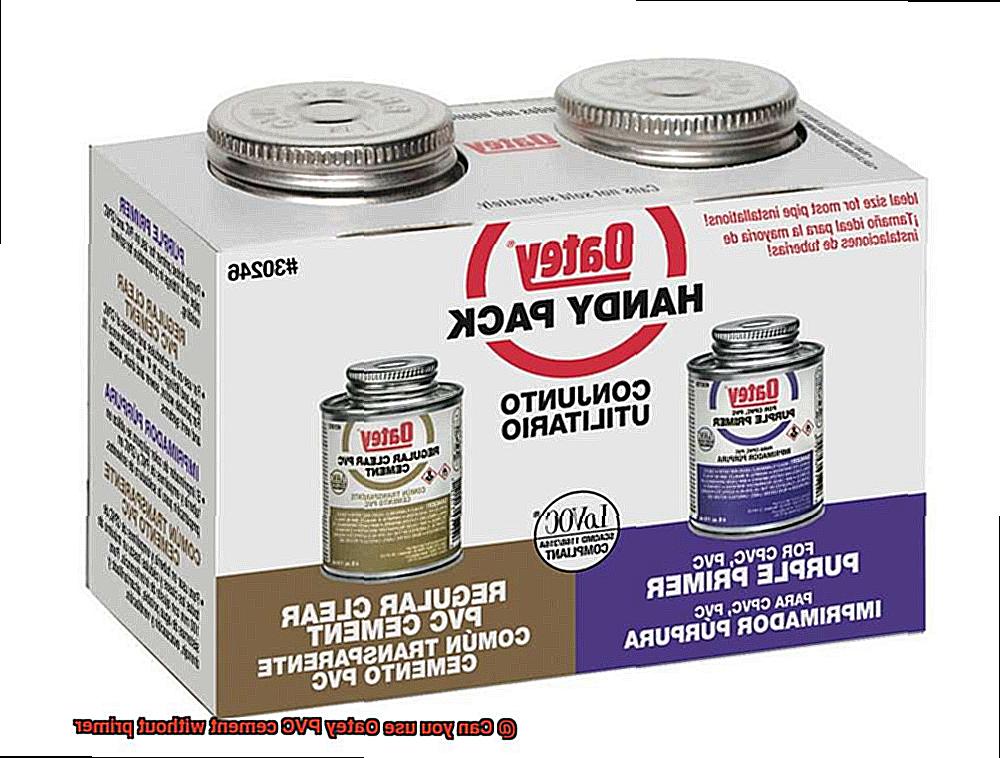
Preparing Surfaces for Bonding without Primer
When it comes to bonding surfaces using Oatey PVC cement, using a primer is typically recommended. However, there are instances where a primer may not be necessary. In this comprehensive guide, we will explore the conditions and considerations needed to prepare surfaces for bonding without primer. Get ready to discover the secrets of achieving optimal adhesion without the need for primer.
Cleanliness is Paramount:
Before attempting to bond surfaces without primer, ensure that they are clean and free from contaminants. Thoroughly remove dirt, grease, or any substances that could hinder the bonding process. This step forms the foundation for a robust and long-lasting bond.
Previous Priming:
If surfaces have been previously primed and remain in good condition, it may be possible to skip the primer step. However, exercise caution and assess whether the previous primer is still effective and compatible with the PVC cement being used. When in doubt, it’s always best to err on the side of caution and apply a new coat of primer.
Surface Preparation:
To enhance adhesion without primer, consider lightly roughening the surfaces using sandpaper or an abrasive material. This process increases the surface area for the PVC cement to adhere to, resulting in a stronger bond. Be careful not to damage or weaken the surfaces during this preparation.
Follow Manufacturer’s Instructions:
Always carefully read and adhere to the manufacturer’s instructions when using Oatey PVC cement without primer. These instructions provide specific guidance on application techniques, required drying times, and other essential considerations. By following these instructions diligently, you can ensure the best possible outcome for your bonding project.
Evaluate Specific Circumstances:
Take into account the unique circumstances of your bonding project before deciding to skip the primer step. Factors such as the type of material being bonded, surface condition, and the expected load or stress on the bond should be carefully considered. When uncertain, seeking advice from a professional ensures the highest quality bond.
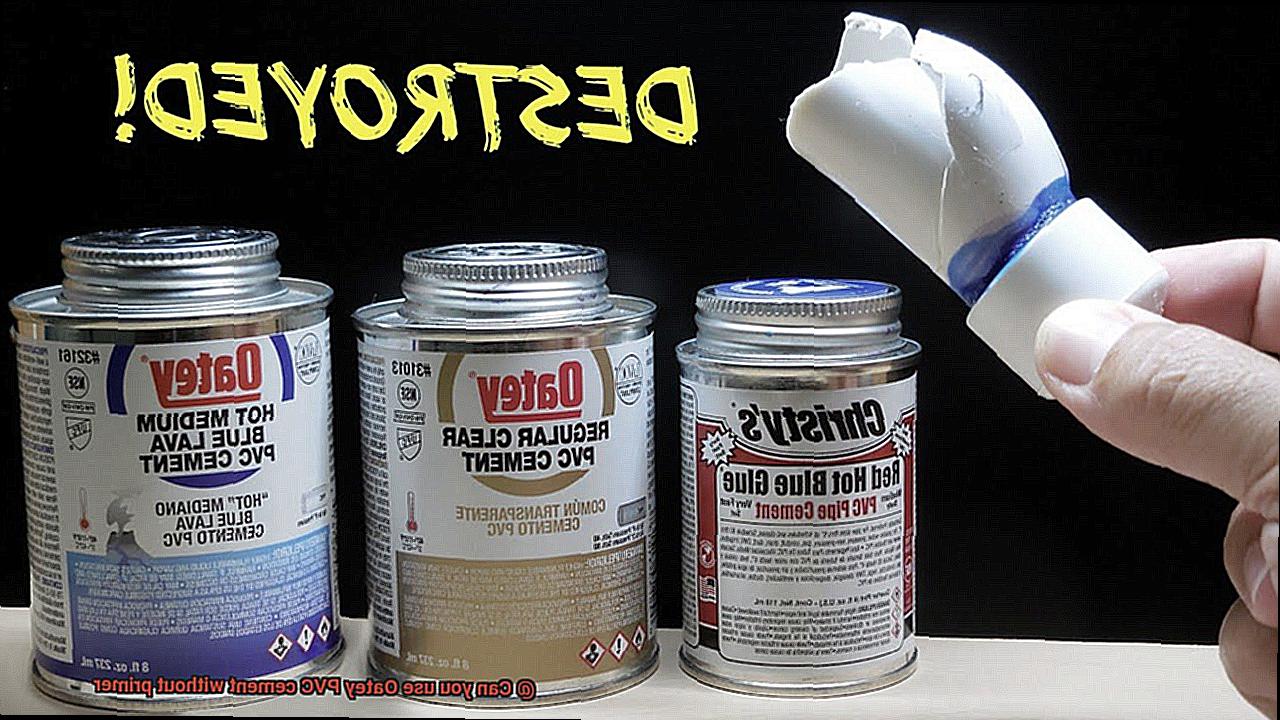
Applying Oatey PVC Cement Without Primer
Oatey PVC cement has emerged as the adhesive of choice for securing PVC pipes and fittings. Traditionally, using a primer alongside this cement has been considered essential for achieving a robust and long-lasting bond. However, a spirited debate rages on among DIYers and professionals regarding the necessity of primer in this process. In this captivating article, we explore the controversy surrounding the application of Oatey PVC cement without primer, offering invaluable insights to help you make an informed decision.
To Primer or Not to Primer? That is the Question:
The Crucial Role of Primer:
Primer serves as the unsung hero in the bonding process, diligently cleaning and preparing the surfaces of PVC pipes and fittings. By doing so, it paves the way for Oatey PVC cement to effectively penetrate and create an unyielding connection. Embracing primer maximizes the adhesive properties of this exceptional cement.
The No-Primer Argument:
Boldly challenging convention, some advocates argue that under specific circumstances, such as when working with pristine and new PVC pipes, primer may be dispensable. They assert that the potent chemical composition of Oatey PVC cement alone possesses the power to forge a satisfactory bond between pipes and fittings.
Weighing Considerations and Caveats:
- Manufacturer Warranties: Disregarding primer may jeopardize any warranties or certifications bestowed by Oatey for their PVC cement. This could have far-reaching implications for future repairs or claims.
- Durability Concerns: While eschewing primer can yield favorable outcomes in certain scenarios, it is vital to acknowledge that using Oatey PVC cement without primer might result in weaker and less enduring connections over time. Primer offers an additional layer of assurance when it comes to long-lasting performance.
Guidelines for Best Practice:
Honor Manufacturer Instructions:
In the quest for optimal adhesion and the preservation of warranties, it is imperative to faithfully follow the instructions provided by Oatey when using their PVC cement. Should the instructions stipulate the use of primer, it is prudent to comply accordingly.
Seek Wisdom from Plumbing Professionals:
When in doubt about the necessity of primer, tapping into the expertise of a seasoned plumber can prove invaluable. Their profound knowledge and experience can offer tailored insights that address the unique requirements of your project.
Conclusion
In conclusion, it is not recommended to use Oatey PVC cement without primer.
While some may argue that it can be done, it is important to consider the long-term consequences. Without using primer, the bond between the PVC pipes may not be as strong or durable.
By taking the extra step of using primer before applying PVC cement, you ensure a proper and secure connection between the pipes.

